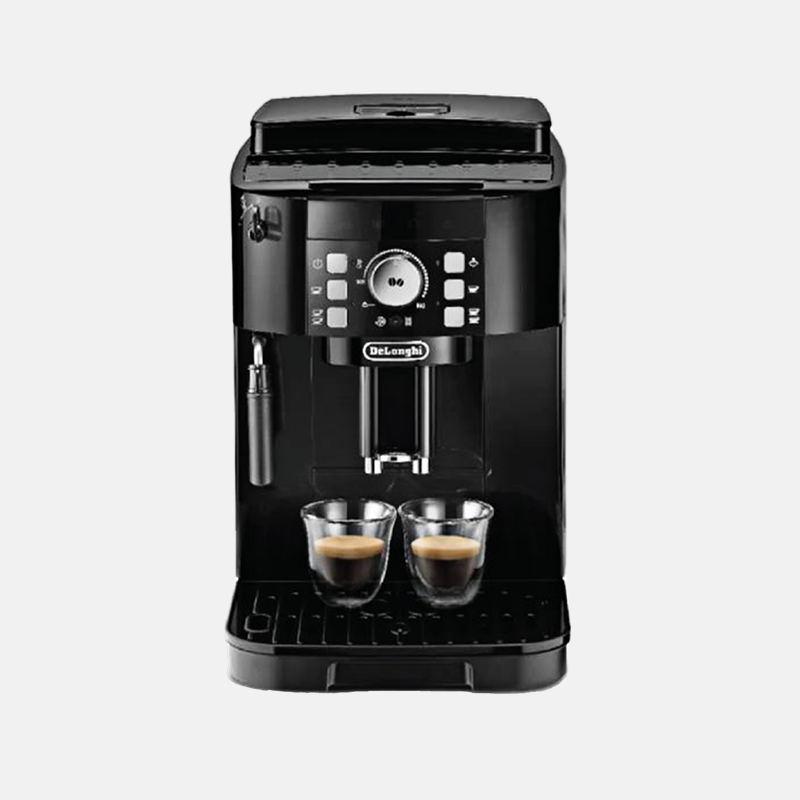☕ Key Features & Specs
-
Formats: Produces espresso, espresso lungo, hot water, and steam with presets for single/double servings.
-
Pump Pressure: 15-bar pump for rich, creamy extraction.
-
Integrated Grinder: Conical steel burr grinder with adjustable grind levels and precise dosing—designed to leave no residual coffee in the grinder.
-
Milk Frothing: Features a manual “Fixed Cappuccino System” steam wand for milk-based drinks; requires hand-frothing technique.
-
Customization: Aroma strength and beverage volume are adjustable; four temperature settings and fragrance controls.
-
Capacity: 250 g bean hopper, 1.8 L water tank, grounds bin holds approx. 14 cycles; passive cup warmer (steel top tray on some variants).
-
Build & Cleaning: Removable brewing group and drip tray; dishwasher-safe parts; touch-button interface overlaid with icons and backlighting.
-
Dimensions & Power: 238 × 430 × 351 mm, ~9 kg, 1,450 W power draw, standby consumption <0.35 W.
-
Warranty: 1 year local warranty standard; MAL market price around RM 1,700–2,100 depending on vendor and offers.
✅ Advantages
-
Convenience: One-touch brewing with built-in grinder makes daily use simple.
-
Good espresso quality: Consistent shots with crema thanks to 15-bar pump and conical grinder.
-
User-friendly interface for both beginners and casual users.
-
Easy maintenance: Descale cycles and a removable brew group help keep it hygienic.
⚠️ Limitations & Common Issues
1. Build quality concerns over time
Some users report leaking issues due to the mechanical brew valve design. The tiny o‑rings inside can wear out and are difficult to service, sometimes requiring full group replacement.
2. Mixed reliability feedback
While many users are satisfied, there are reports of early malfunction (e.g. false full-grounds lights, grinder jams) and slow or unhelpful customer service response.
3. Espresso strength may vary
Some users experienced watery or weak espresso unless grind settings are fine-tuned or adjusted frequently.
4. All‑in‑one limitations
As a super‑automatic machine, it has trade‑offs: less control and personalization than semi‑automatic or manual setups. Power users often prefer separate grinders or semi‑auto machines once they develop barista skills.
📊 Quick Overview
| Feature | Details |
|---|---|
| Strengths | Easy operation, integrated grinder, compact |
| Best For | Daily espresso users, occasional milk drinks |
| Weaknesses | Potential leaks, limited durability design |
| Ideal Users | Home users wanting convenience over precision |
🎯 Should You Consider It?
It’s a convenient entry-level super-automatic espresso machine ideal for users wanting freshly ground espresso at the touch of a button—no barista training required. The manual steam wand offers flexibility for milk-based drinks.
However, if you’re seeking long-term reliability, high customization, or power-player features (like PID, pressure profiling, or auto milk frothing), you might prefer mid-range semi-automatic machines (e.g. Gaggia Classic) or higher-tier De’Longhi models (like the ECAM22 series or Dinamica) that use improved materials and interfaces.
🛠 Tips If You Plan to Buy
-
Fine-tune grind settings, especially if your espresso comes out watery—grind finer to slow extraction.
-
Regular cleaning and descaling is essential—brew group, drip tray, grinder.
-
Water hardness calibration improves taste and longevity.
-
Keep spare brewing group o‑rings or a service kit handy if issues arise—especially in regions where repair is not convenient.
















